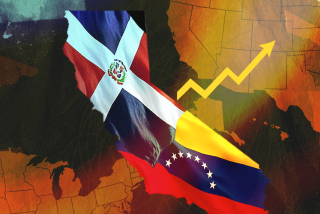HIV Infection Among Gay Men Jumps 17%
- Share via
WASHINGTON — The number of gay men newly diagnosed with HIV infection in the United States was 17% higher last year than in 1999, according to data released Wednesday by government epidemiologists.
Among ethnic groups, Latinos had the largest increase in cases, with 26% more people first diagnosed with the virus last year than four years ago. Among whites, the number of new diagnoses in 2002 was 8% higher than the number of new diagnoses in 1999.
The number of blacks and Asians newly diagnosed in those two years remained stable.
The information, announced by the Centers for Disease Control and Prevention, comes from 29 states that count all new positive HIV tests each year. The data are considered the best window onto the state of the AIDS epidemic nationwide. The trends are similar to ones announced this year from a smaller number of states.
“We need to remind not just the groups at risk, but the American public, that HIV and AIDS is not over in the United States,” said Ronald Valdiserri, a physician and epidemiologist at the CDC.
Several European countries and Australia have also seen a rise in the number of new HIV diagnoses in gay men in recent years.
Experts attribute the trend to two things: a complacency about risky behavior that arose in the wake of lifesaving antiretroviral therapy, and a new generation of gay men with no memory of the epidemic’s early, devastating years.
“We have to continue to work with communities and medical care providers to reinforce the importance of maintaining safer behaviors,” Valdiserri said.
The unusually steep rise among Latinos is seen for the first time in this report. About two-thirds of the Latinos newly diagnosed last year were gay men.
The report includes data from Florida and New Mexico, both of which have large Latino populations, but not from New York or California, which also have them.
“I don’t think we can say it’s a valid national sample yet for Latinos,” Valdiserri said.
Nevertheless, spokesmen for two activist groups found the numbers ominous.
“The messages of a decade ago may not be reaching the groups that are impacted today,” said Carole Bernard of the National Minority AIDS Council. “What is needed, really, is ‘HIV/AIDS 101,’ explaining what the disease is, how it’s transmitted and how people can protect themselves.”
Carlos Velazquez, director of national prevention programs at the National Latina/o Lesbian, Gay, Bisexual and Transgender Organization, called the increases “alarming but not surprising.”
“There have been tremendous efforts to prevent AIDS in white gay communities and in white communities as a whole. But efforts that focus on Latino communities, and gay Latino communities in particular, have been minimal,” he said.
More to Read
Sign up for Essential California
The most important California stories and recommendations in your inbox every morning.
You may occasionally receive promotional content from the Los Angeles Times.










